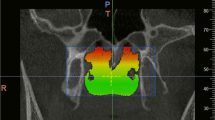Abstract
Purpose
To identify and determine variations on eye distance in patients with bilateral nasal polyposis (BNP) compared to a healthy control group.
Methods
This is a case–control study that included 20 BNP patients and 40 healthy controls. We included all patients with BNP confirmed by pathology and a computed tomography scan. A healthy control group was admitted, filtered by the exclusion criteria of nasal polyposis, craniofacial malformations, and encephalocele. Paranasal sinus CT scans were performed in all participants, and two measures were evaluated, the interoptic (soft tissue) and the interzygomatic (bone structure) distances.
Results
A total of 20 BNP subjects, 13 (65%) male and 7 (35%) female, with a mean age of 38.8 years, and 40 healthy controls, 16 (40%) male and 24 (60%) female with a mean age of 43.2 years, were included. The mean interoptic distance was 69.7 mm (71.9 mm men, 66.4 mm women) and interzygomatic distance was 103.1 mm (104.5 mm men, 100.6 mm women). A significant increase of the interoptic (p < 0.001) and interzygomatic (p < 0.002) measurements was found in patients with polyposis compared to the controls. In the receptor operative curve analysis, the interoptic distance had an area under a curve of 96% and the threshold that maximizes the sensitivity and specificity was 59.85 mm (sensitivity 90%, specificity 95%, PPV 90%, NPV 95%).
Conclusions
An increase in ocular and orbital distances was identified in patients with BNP. Polyposis may be identified by measuring eye separation. The established cut point distance identifies patients that may benefit from follow-up. Further research in this study line is suggested.



Similar content being viewed by others
References
Rizk HG, Ferguson BJ (2012) Categorizing nasal polyps by severity and controller therapy. Arch Otolaryngol Head Neck Surg 138(9):846–853
Haro J, Hernández A, Benítez P, Ares JA (2010) Smell disorders as early diagnosis in the early stage of sinonasal polyposis. Acta Otorrinolaringol Esp 61(3):209–214
Settipane GA (1996) Epidemiology of nasal polyps. Allergy Asthma Proc 17(5):231–236
Majithia A, Tatla T, Sandhu G, Saleh H, Clarke P (2007) Intracranial polyps in patients with Samter’s triad. Am J Rhinol 21(1):59–63
Chaaban M, Walsh E, Woodworth B (2013) Epidemiology and differential diagnosis of nasal polyps. Am J Rhinol Allergy 27(6):473–478
Woakes E (1893) Further observations on “Necrosing Ethmoiditis”. Br Med J 1693:1216–1218
Wentges R (1972) Edward Woakes: the history of an eponym. J Laryngol Otol 86(5):501–512
Greig M (1924) Hypertelorism. Edinb Med J 31(10):560–593
Tessier P (1972) Orbital hypertelorism: I. Successive surgical attempts. Material and methods. Causes and mechanisms. Scand J Plast Reconstr Surg Hand Surg 6(2):135–155
Sharma R (2014) Hypertelorism. Indian J Plastic Surg 47(3):284–292
Johansson L, Akerlund A, Holmberg K, Melén I (2000) Evaluation of methods for endoscopic staging of nasal polyposis. Acta Otolaryngol 120(1):72–76
Ural A, Işik A, Minovi A, Cobanoğlu B, Bahadir O, Imamoğlu M (2009) Correlation of orbital dysmorphisms with nasal polyposis: a clinical study. Eur Arch Otorhinolaryngol 266(12):1891–1894
Groman JD, Bolger W, Brass-Ernst L, Macek M, Zeitlin P, Cutting G (2004) Recurrent and destructive nasal polyposis in 2 siblings: a possible case of Woakes’ syndrome. Otolaryngol Head Neck Surg 131(6):1009–1011
Weber A, Wilson W, Montgomery W (1982) Hypertelorism in nasal and paranasal sinus polyposis. Ann Otol Rhinol Laryngol 91(3):344–345
Funding
Neither the research, nor the authors received any specific grant from funding agencies in the public, commercial, or not-for-profit sectors.
Author information
Authors and Affiliations
Corresponding author
Ethics declarations
Conflict of interest
The corresponding author had full access to all the data in the study and takes responsibility for the integrity of the data and the accuracy of the data analysis. There is no conflict of interest. Neither the research nor the authors received a specific grant from any funding agency in the public, commercial, or not-for-profit sectors.
Ethical approval
The research protocol was approved by the local Research and Ethics Committee with the registry key OT16-00001.
Additional information
Publisher’s Note
Springer Nature remains neutral with regard to jurisdictional claims in published maps and institutional affiliations.
Rights and permissions
About this article
Cite this article
Treviño-González, J.L., Campos-Coy, M.A., Villegas-González, M.J. et al. Impact of bilateral nasal polyposis on the interoptic and interzygomatic distance. Eur Arch Otorhinolaryngol 276, 1701–1705 (2019). https://doi.org/10.1007/s00405-019-05390-z
Received:
Accepted:
Published:
Issue Date:
DOI: https://doi.org/10.1007/s00405-019-05390-z




